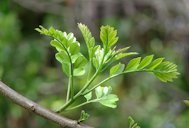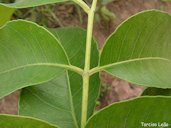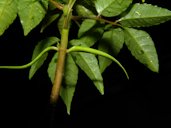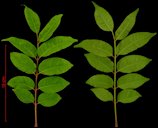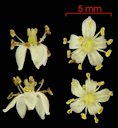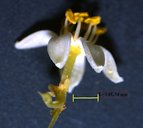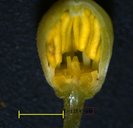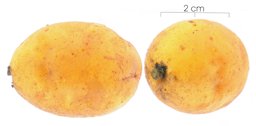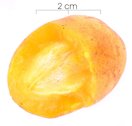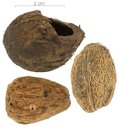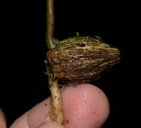| Mombin, Yellow - Spondias mombin | |||||||||||||||||||||||||||
|---|---|---|---|---|---|---|---|---|---|---|---|---|---|---|---|---|---|---|---|---|---|---|---|---|---|---|---|
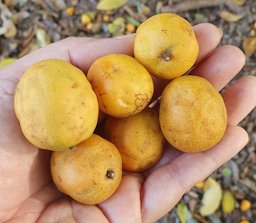 Fig. 1  Yellow mombin, Spondias mombin, Paseo De Los Indios, Santo Domingo, República Dominicana 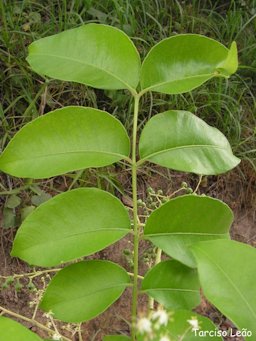 Fig. 2  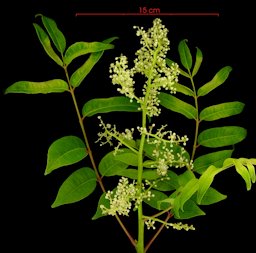 Fig. 8  S. mombin, Panama, Barro Colorado Island 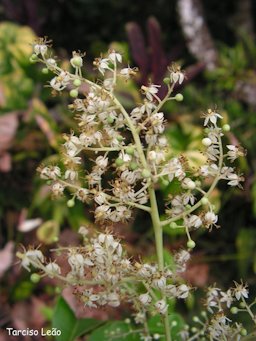 Fig. 9  S. mombin, cajá 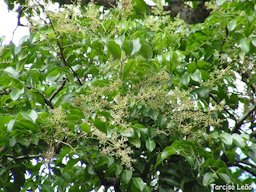 Fig. 10  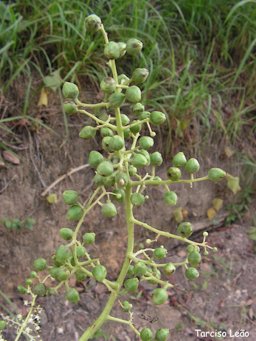 Fig. 14  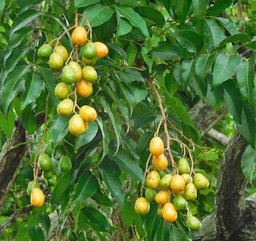 Fig. 15  Ashanti plum, yellow mombin 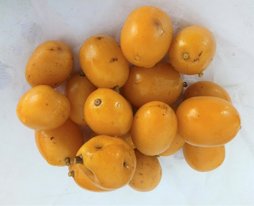 Fig. 16  S. mombin 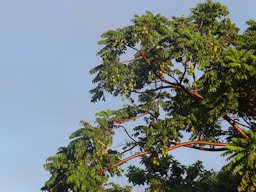 Fig. 22  El árbol de Jobo se eleva fuerte al cielo par sus frutar cargar, Tocomita, Bolívar 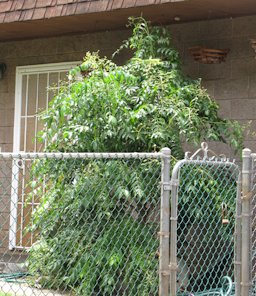 Fig. 23  Spondias mombin (habit), Wailuku, Maui, Hawai'i 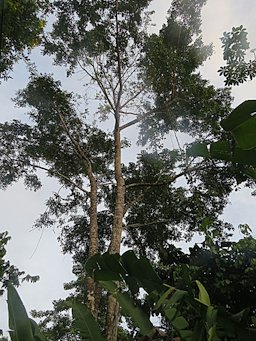 Fig. 24  Spondias mombin tree.This species has gone from Neotropical to Pantropical, due to edible fruit and folk medicine applications. Jobo is one of the more popular names. Anacardiaceae. 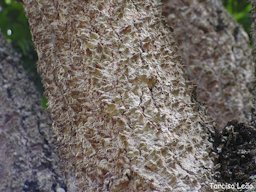 Fig. 25  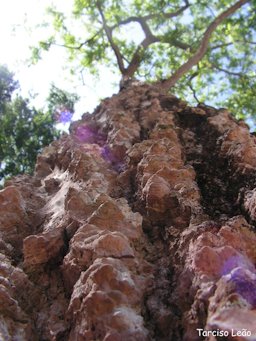 Fig. 26  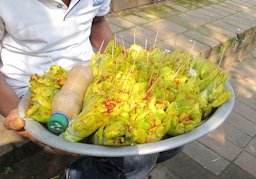 Fig. 27  A hog plum (Spondias mombin) served as a snack with chilli powder, Dhaka, Bangladesh 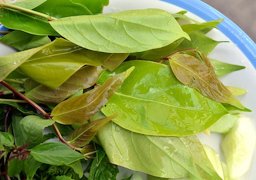 Fig. 28  Bai makok (Thai) is the leaf of the S. mombin, a relative of the cashew, taste is sour and slightly bitter; The young leaves are served raw with certain types of nam phrik (Thai chilli pastes). 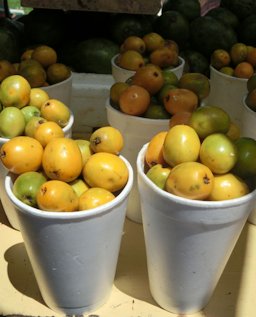 Fig. 29  The edible fruit of S. mombin as sold on streets in Santo Domingo, Domincican Republic; the fruit is called Jobo here |
Scientific
name Spondias mombinJacq. Common names English: yellow mombin, hog plum; Caribbean Islands: hog plum; Jamaica: Spanish plum, gully plum; Malaya: thorny hog plum; Ghana: hog plum, Ashanti plum; Spanish: caimito, chupandilla, ciruela agria, ciruela amarilla, ciruela de jobo, ciruela del pais, ciruela de monte, ciruela loca, cirueld mango, ciruela obo, cuajo, guama zapotero, hobo de monte, hubu, jobillo, jobito, jobo, jobo arisco, joboban, jobo blanco, jobo de Castilla, Jobo de perro, jobo de puerco, jobo espino, jobo espinoso, jobo gusanero, jobo hembra, jobo jocote, jobo negro, jobo roñoso, jobo vano, jocote, jocote amarillo, jocote de chanche, jocote dejobo, jocote jobo, jocote montanero, jocote montero, jovo, marapa, obo de zopilote, palo de mulato, noma, tobo de montana, obo and uvo; Portuguese: acaiba, acaimiri, acaja, acajaiba, caja, caja mirim, caja pequeno, cajazeiro, caja miudo; French: mombin franc, mombin fruits jaunes, mombinier, myrobalane, prune mombin, prune myrobalan, prunier mombin; Surinam: hoeboe, mompe, monbe, mopé and moppé; Amazonian Indians: taperiba, tapiriba (fruit of the tapir) 2 Synonyms Mauria juglandifolia Benth. ex Engl., S. aurantiaca Schumach. & Thonn., S. brasiliensis Mart. ex Engl., S. dubia A.Rich., S. glabra Engl., S. graveolens Macfad., S. lutea L., S. lutea var. glabra Engl., S. lutea var. maxima Engl., S. maxima Engl., S. mombin var. mombin, S. pseudomyrobalanus Tussac 3 Relatives S.tuberosa, S. pinnata, S. acida, S. novoguineensis, and S. borbonica, cashew (Anacardium occidentale), mango (Mangifera indica), and pistachio (Pistacia vera) 1 Family Anacardiaceae (cashew family) Origin Southern Mexico to Peru and Brazil 2 USDA hardiness zones 11-12 Uses Fruit; shade Height 60 ft (18 m) 5 Spread 50 ft (15 m) 4 Crown Open or densely closed canopy, depending on the vigour of the individual 4 Plant habit Erect, stately; somewhat buttressed; young trees, bearing many blunt-pointed spines or knobs; branches 6.5-33 ft ( 2-10 m) above ground level 2,4 Growth rate Fast Trunk/bark/branches Bark greyish-brown; thick; rough; often deeply grooved; blunt, spinelike projections 4 Pruning requirement Maintain at 12-15 ft (3.5-4.5 m) (Fig. 23) 1 Leaves Deciduous; alternate;pinnate; hairy, often pinkish, petioles; 9-19 pointed leaflets, inequilateral, oblique at the base 2 Flowers Small; fragrant; whitish; male, female and bisexual flowers are borne, after the new leaves 2 Fruit (climacteric) Ovoid or ellipsoid drupe; dull light orange to yellow or brown; clusters of 1-20; thin, leathery skin; juicy orange or yellow pulp; single large corky stone; grooved coat surrounding 4-5 small seeds 4,8 Season Aug. -Nov. 1 Light requirement Full sun Soil tolerances Does well in a great variety of soils pH preference 5-7 7 Drought tolerance Mature trees are drought tolerant Cold tolerance Severely damaged by freezing temperatures 4 Plant spacing 25-30 ft (7.5-9 m) 4 Roots Potable water can be derived from the roots in emergency 2,4 Seedlings with deep taproot, probably persisting in mature tree; shallower root system near the surface 4 Invasive potential * None reported Pest resistance Pests do not appear to be a problem in Florida 1 Known hazard In tropical Africa, excessive indulgence in the fruits is said to cause dysentery 2 Reading Material Spondias Growing in the Florida Home Landscape, University of Florida pdf Yellow Mombin, Fruits of Warm Climates The Yellow Mombin, Manual Of Tropical And Subtropical Fruits Spondias mombin, Agroforestry Database Origin/Distribution The tree is native and common in moist lowland forests from southern Mexico to Peru and Brazil, and in many of the West Indies. It has been planted in Bermuda; is grown to a limited extent in India and Indonesia; is rare in Malaya, but widely cultivated and naturalized in tropical Africa. 2 Description Jobo, Spondias mombin L., which grows wild, is planted as a row tree and for its fruit. It is recognized by: (1) numerous spinelike projections (Fig. 25) 1/4-3/4 in. (0.6-2 cm) long on the thick, corky bark of the trunk (Fig. 26); (2) a very spreading yellow-green crown, usually with few nearly horizontal branches; (3) pinnate leaves 8-16 in. (20-40 cm) or more in length with 9-19 asymmetrical ovate or lance-shaped, short or long-pointed, thin leaflets; (4) numerous small, fragrant, yellowish-white, 5-parted flowers nearly 1/4 in. (0.6 cm) across in showy branched terminal clusters; and (5) clusters of yellow, cylindrical, soft, juicy fruits 1 1/4-1 1/4 in. (3.2x3.2 cm) long and 3/4-l in. (2-2.5 cm) in diameter, edible though inferior. 5 Leaves The alternate leaves have slender and finely hairy axes. The leaflets are more or less paired except for the terminal one, on stalks 1/8-1/4 inch (0.3- 0.6 cm) long. Leaflet blades are 2-4 inches (5-10 cm) long and 1/8-1/4 inches (0.3- 0.6 cm) broad, short-pointed or rounded and oblique at base, the edges not toothed or slightly wavy, yellow-green on upper surface and paler beneath. 5 Leaves are very aromatic when crushed. 8
Fig. 1,5. S. mombin, (leaves), Enchanting Gardens of Kula, Maui, Hawai'i Fig. 6,7. S. mombin, Charcos, Puntarenas, Costa Rica Flowers Flower clusters are terminal, 6-12 in. (15-30 cm) long. Individual flowers are about 0.25 in. (0.6 cm) across, with male, female, and bisexual flowers on the same tree. The petals are white and the center stamens (male and bisexuals) tipped with yellow. 6 Flowers are held on 8-24-inch (20-60 cm) long terminal panicles. There may be up to 2,000 flowers per panicle. 1
Fig. 11. S. mombin, Panama, Barro Colorado Island Fig. 12. S. mombin, Charcos, Puntarenas, Costa Rica Pollination The flowers are worked intensively by honeybees early in the morning. 2 Fruit The fruit, hanging in numerous, branched, terminal clusters of a dozen or more, is aromatic, ovoid or oblong, 1 1/4 to 1 1/2 in (3.2-4 cm) long and up to 1 in (2.5 cm) wide; golden-yellow; with thin, tough skin, and scant, medium-yellow, translucent, fibrous, very juicy pulp, somewhat musky, very acid, clinging to the white, fibrous or "corky" stone (Fig. 19,20). 2 The skin of the jobo is thin and yellow, its pulp has an acidic flavor and is very aromatic, so much so that its smell, at the time of the fruiting of the tree, permeates the air. Flavor reminiscent of mango. 7,8
Fig. 17,18,19. S. mombin, Panama, Barro Colorado Island Harvesting Spondias should be carefully picked by hand because their peel is thin and easily broken. Fruit quality is best when fruit is allowed to ripen or nearly ripen on the tree. Ripe fruit may be eaten immediately or refrigerated for several days. Non-ripe fruit should not be refrigerated until ripe. 1 Large trees may yield well over 220 pds (100 kg) of fruit. 7 Propagation Known as the cajá in Brazil, it reproduces by seeds. It can be propagated by asexual reproduction, which is preferable for speed, by rooting cuttings of mature wood, 20-40 in. ( 50-100 cm) long, and 2-4 in. (5-10 cm) in diameter. Vegetative propagation by grafting can also be carried out. 7
Fig. 20,21. S. mombin, Charcos, Puntarenas, Costa Rica Planting When planting Spondias spp., select a section of the yard in full sun with rapidly draining soil that is free of standing water after typical summer rains. If there is a potential for flooding, plant the tree on a berm (mound made up of native soil) 2 to 3 ft high (0.6 to 0.9 m) by 4 to 6 ft in diameter (1.2 to 1.8 m). 1 Culture S. mombin occurs in a great variety of humid tropical climates, often in secondary vegetation derived from evergreen lowland forest or semi-deciduous forest. It has been introduced to most tropical locations and performs well under varied conditions. The tree is tolerant of most soil types and rainfall patterns. S. mombin is severely damaged by freezing temperatures. 4 Pruning Annual or biannual pruning is recommended to control tree size, but care must be taken not to make too large a wound because the soft and brittle nature of these trees can lead to rot in the open wounds. It is recommended that selective pruning to control tree height (and occasionally width) be undertaken during a period of hot dry weather to facilitate the wound healing process. 1 Fertilizing There are no field-trial-based fertilizer recommendations available for spondias. Observation of trees in Florida indicates that they will grow and fruit well with very little input; however, small amounts of fertilizer may enhance fruit yields and size. Young trees can be fertilized every two to three months during the first year, beginning with a 1/4 lb (114 g) allotment of fertilizer and gradually increasing to one pound (455 g). Thereafter, 2 to 4 applications per year in amounts proportionate to the increasing size of the tree are sufficient. Use no more than 10 to 12 lbs per tree, per year for mature trees. 1 Irrigation Watering during flowering and fruit development may improve fruit set and size. Newly planted and young trees may need to be watered during severe drought conditions. 1 Pests Insect pests and diseases are minimal and should be controlled only in severe situations. 1 Food Uses The pulp of the fruit is sometimes eaten directly, especially when found in the forest, but is too acid to be considered attractive; it can also be boiled or dried. It is especially used for syrup, ice cream, drinks and jellies. Juices improve with keeping overnight as the mild astringency of the fresh fruit disappears. Fermented products are also good. There is great variation in fruit quality from region to region, some being sweet and pleasant and others quite disagreeable in flavour. 4 In Amazonas, the fruit is used mainly to produce wine sold as " Vinho de Taperiba". In Guatemala, the fruit is made into a cider-like drink. 2 Mexicans pickle the green fruits in vinegar and eat them like olives with salt and chili, as they do with the unripe purple mombin. 2 Young leaves are cooked as greens. 2 Nutrient Content About half of the fruit weight is pulp, which is 8% water, 10% sugars, 1-8% fibre, and 0.4% ash. The sugars give about 40 calories/100 g. The fruit is a good source of vitamins A and C; vitamin C quantities vary between 34 and 54 mg/g, and carotenoids are presumably present in reasonable concentrations. 4 Medicinal Properties ** The fruit juice is drunk as a diuretic and febrifuge. The decoction of the astringent bark serves as an emetic, a remedy for diarrhea, dysentery, hemorrhoids and a treatment for gonorrhea and leucorrhea; and, in Mexico, it is believed to expel calcifications from the bladder. The powdered bark is applied on wounds. A tea of the flowers and leaves is taken to relieve stomachache, biliousness, urethritis, cystitis and eye and throat inflammation. In Belize, a decoction of the young leaves is a remedy for diarrhea and dysentery. The juice of crushed leaves and the powder of dried leaves are used as poultices on wounds and inflammations. The gum is employed as an expectorant and to expel tapeworms. 2 Other Uses Gum: The tree exudes a gum that is used as a glue. Wood: The wood is yellow or yellowish-brown with darker markings; light in weight, buoyant, flexible, strong; prone to attack by termites and other pests. It is much used in carpentry, also for matchsticks, match-boxes, physician's spatulas, sticks for sweetmeats, pencils, pen-holders, packing cases, interior sheathing of houses and boats and as a substitute for cork. It is not suited for turnery and does not polish well. In Brazil, the woody tubercles on the trunk are cut off and used for bottle stoppers and to make seals for stamping sealing wax. In tropical Africa, saplings serve as poles for huts; branches for garden poles and for axe and hoe handles. In Costa Rica and Puerto Rico the wood is employed only as fuel. Ashes from the burned wood are utilized in indigo-dyeing in Africa. 2 Bark: The bark, because of its tannin content, is used in tanning and dyeing. It is so thick that it is popular for carving amulets, statuettes, cigarette holders, and various ornamental objects. 2 The trees are planted as living fenceposts and for shade and ornament, being readily propagated by cuttings and fast growing when not in deep shade. 5 Its great adaptability has made the plant an efficient alternative for erosion control and recovery of degraded soils. 7 Spondias Relative The imbu, Spondias tuberosa Arruda, is native to dry areas of Brazil. It has enlarged roots and is extremely resistant to drought. It has been introduced to other areas but is not well-known. The ovoid fruit is 3 1/2-4 cm (1 1/2 in.) in length and greenish-yellow in color when ripe. It is eaten fresh and made into jellies or desserts and is much esteemed in its native areas. It does not grow well in southern Florida, evidently because of poor adaptation to the soil and climate. 9 Of the several fruits belonging to the genus Spondias which are grown in various parts of the tropics, the imbu, although relatively little known, is perhaps the best. It merits cultivation wherever climate and soil are suited to its growth. 10 The Imbu, Manual Of Tropical And Subtropical Fruits Other Edible Spondias species: Ambarella, S. dulcis Purple Mombin, S. purpurea Further Reading Spondias Species, Archives of the Rare Fruit Council of Australia Spondias Species Botanical Art List of Growers and Vendors |
||||||||||||||||||||||||||
| Bibliography 1 Crane, Jonathan H., and Jeff Wasielewski. "Spondias growing in the Florida Home Landscape." Horticultural Sciences Dept., UF/IFAS Extension. Original pub. Apr. 1994, Revised Jan. 2019, AskIFAS, edis.ifas.ufl.edu/publication/MG059. Accessed 13 Jan. 2023. 2 Fruits of Warm Climates. Julia F. Morton. Miami, 1987. 3 "Spondias mombin L." World Flora Online, WFO (2023), www.worldfloraonline.org/taxon/wfo-0000435470. Accessed 20 Jan. 2023. 4 Orwa, C., et al. "Spondias mombin L." Agroforestree Database: a tree reference and selection guide, version 4.0., 2009, Agroforestry, apps.worldagroforestry.org/treedb2/speciesprofile.php?Spid=1543. Accessed 20 Jan. 2023. 5 Little, Elbert L., and Frank H. Wadsworth. "Common trees of Puerto Rico and the Virgin Islands." Series: Agriculture handbook no. 249, United States, Dept. of Agriculture, July 1964, pp. 62-63, Biodiversity Heritage Library, doi.org/10.5962/bhl.title.4135. Accessed 21 Jan. 2023. 6 Kirk, Kent T. Tropical trees fo Florida and the Virgin Islands. A Guide to Identification, Characteristics and Uses. Sarasota, Pineapple Press, 2009, 2017. 7 Cartay, Rafael. "The Jobo, Hog plum, or Ashanti plum (Spondias mombin)." Rainforest Online Encyclopedia, 11 Mar. 2020, delamazonas.com/en/flora1/fruit/hog-plum-spondias-mombin/. Accessed 21 Jan. 2023. 8 Blancke, Rolf. Tropical Fruits and Other Edible Plants of the World: An Illustrated Guide. China, Comstock Publishing Ass., a division of Cornell University Press, 2016. 9 Campbell, Carl W., and Julian W. Sauls. "Spondias Species." IFAS/UF Fruit Crops Fact Sheet: Spondias in Florida FC-63, May 1994, [Archived], via Archives of the Rare Fruit Council of Australia, rfcarchives.org.au. Accesssed 27 Jan. 2015. 10 Popenoe, Wilson. Manual Of Tropical And Subtropical Fruits. 1920, London, Hafner Press, 1974. Photographs Fig. 1 Leon, Yolanda M. "Yellow Mombin, Spondias mombin, Paseo De Los Indios, Santo Domingo, República Dominicana." iNaturalist, Research Grade, 11 Aug. 2020, (CC BY-NC 4.0), www.inaturalist.org/observations/56180603. Accessed 22 Jan. 2023. Fig. 2 Tarciso, Leao'. "Spondias mombin, caja." Wikimedia Commons, via Flickr, 1 Jan. 2004, (CC BY 2.0), commons.wikimedia.org/wiki/File:Spondias_mombin,_cajá_-_Flickr_-_Tarciso_Leão_(4).jpg. Accessed 23 Apr. 2015. Fig. 3 Starr, Forest and Kim. "Spondias mombin (leaves), Enchanting Gardens of Kula, Maui, Hawai'i." Starr Environmental, 16 July 2008, no. 080716-9383, (CC BY 4.0), Image cropped, starrenvironmental.com/images/image/?q=24924139875. Accessed 22 Jan. 2023. Fig. 4 Tarciso, Leao'. "Spondias mombin, caja." Wikimedia Commons, via Flickr, 1 Jan. 2004, (CC BY 2.0), commons.wikimedia.org/wiki/File:Spondias_mombin,_cajá_-_Flickr_-_Tarciso_Leão_(3).jpg. Accessed 23 Apr. 2015. Fig. 5 Starr, Forest and Kim. "Spondias mombin (leaves), Enchanting Gardens of Kula, Maui, Hawai'i." Starr Environmental, 24 Oct. 2007, no. 071024-0340, (CC BY 4.0), starrenvironmental.com/images/image/?q=24776526252. Accessed 22 Jan. 2023. Fig. 6 Aiguilar, Reinaldo. "Spondias mombin L." Flckr, 26 Apr. 2013, Vascular Plants of the Osa Peninsula, Costa Rica, (CC BY-NC-SA 2.0), www.flickr.com/photos/plantaspeninsulaosa/8769118353. Accessed 22 Jan. 2023. Fig. 7 Paton, Steve. "Spondias mombin L., Panama, Barro Colorado Island." Environmental Sciences Program, Smithsonian Tropical Research Institute, 17 Mar. 2005, (CC BY-NC 3.0), biogeodb.stri.si.edu/bioinformatics/dfm/metas/view/10313. Accessed 22 Jan. 2023. Fig. 8 Paton, Steve. "Spondias mombin L., Panama, Barro Colorado Island." Environmental Sciences Program, Smithsonian Tropical Research Institute, 17 Mar. 2005, (CC BY-NC 3.0), biogeodb.stri.si.edu/bioinformatics/dfm/metas/view/10309. Accessed 22 Jan. 2023. Fig. 9 Tarciso, Leao'. "Spondias mombin, caja." Wikimedia Commons, via Flickr, 1 Jan. 2004, (CC BY 2.0), commons.wikimedia.org/wiki/File:Spondias_mombin,_cajá_-_Flickr_-_Tarciso_Leão_(9).jpg. Accessed 23 Apr. 2015. Fig. 10 Tarciso, Leao'. "Spondias mombin, caja." Wikimedia Commons, via Flickr, 1 Jan. 2004, (CC BY 2.0), commons.wikimedia.org/wiki/File:Spondias_mombin,_cajá_-_Flickr_-_Tarciso_Leão_(6).jpg. Accessed 23 Apr. 2015. Fig. 11 Paton, Steve. "Spondias mombin L., Panama, Barro Colorado Island." Environmental Sciences Program, Smithsonian Tropical Research Institute, 14 Apr. 2004, (CC BY-NC 3.0), biogeodb.stri.si.edu/bioinformatics/dfm/metas/view/10306. Accessed 22 Jan. 2023. Fig. 12 Aiguilar, Reinaldo. "Spondias mombin L." Flckr, 26 Apr. 2014, Vascular Plants of the Osa Peninsula, Costa Rica, (CC BY-NC-SA 2.0), Image cropped, www.flickr.com/photos/plantaspeninsulaosa/14024287705. Accessed 22 Jan. 2023. Fig. 13 Aiguilar, Reinaldo. "Spondias mombin L." Flckr, 26 Apr. 2014, Vascular Plants of the Osa Peninsula, Costa Rica, (CC BY-NC-SA 2.0), Image cropped, www.flickr.com/photos/plantaspeninsulaosa/14021093831. Accessed 22 Jan. 2023. Fig. 14 Tarciso, Leao'. "Spondias mombin, caja." Wikimedia Commons, via Flickr, 1 Jan. 2004, (CC BY 2.0), commons.wikimedia.org/wiki/File:Spondias_mombin,_cajá_-_Flickr_-_Tarciso_Leão_(7).jpg. Accessed 23 Apr. 2015. Fig. 15 Filo gèn'. "Ashanti plum, Yellow mombin." Wikimedia Commons, 3 Aug. 2017, GFDL, (CC BY-SA 4.0), commons.wikimedia.org/wiki/File:Spondias_mombin.jpg. Accessed 21 Jan. 2023. Fig. 16 Adoscam. "Spondias mombin sur un papier blanc." Wikimedia Commons, 18 July 2021, (CC BY-SA 4.0), Image cropped, commons.wikimedia.org/wiki/File:Spondia_mombin_(Fruit)_sur_un_papier_blanc_au_Bénin_04.jpg. Accessed 21 Jan. 2023. Fig. 17 Paton, Steve. "Spondias mombin L., Panama, Barro Colorado Island." Environmental Sciences Program, Smithsonian Tropical Research Institute, 23 Oct. 2092, (CC BY-NC 3.0), biogeodb.stri.si.edu/bioinformatics/dfm/metas/view/10310. Accessed 22 Jan. 2023. Fig. 18 Paton, Steve. "Spondias mombin L., Panama, Barro Colorado Island." Environmental Sciences Program, Smithsonian Tropical Research Institute, 23 Oct. 2002, (CC BY-NC 3.0), biogeodb.stri.si.edu/bioinformatics/dfm/metas/view/10316. Accessed 22 Jan. 2023. Fig. 19 Paton, Steve. "Spondias mombin L., Panama, Barro Colorado Island." Environmental Sciences Program, Smithsonian Tropical Research Institute, 12 Sept. 2003, (CC BY-NC 3.0), biogeodb.stri.si.edu/bioinformatics/dfm/metas/view/10314. Accessed 22 Jan. 2023. Fig. 20 Aiguilar, Reinaldo. "Spondias mombin L." Flckr, 26 Apr. 2013, Vascular Plants of the Osa Peninsula, Costa Rica, (CC BY-NC-SA 2.0), Image cropped, www.flickr.com/photos/plantaspeninsulaosa/8769117391. Accessed 22 Jan. 2023. Fig. 21 Aiguilar, Reinaldo. "Spondias mombin L." Flckr, 26 Apr. 2013, Vascular Plants of the Osa Peninsula, Costa Rica, (CC BY-NC-SA 2.0), Image cropped, www.flickr.com/photos/plantaspeninsulaosa/8773929656. Accessed 22 Jan. 2023. Fig. 22 Samuelistok. "El árbol de Jobo se eleva fuerte al cielo par sus frutar cargar. Tocomita. Bolívar." Wikimedia Commons, 7 Aug. 2013, (CC BY-SA 3.0), commons.wikimedia.org/wiki/File:Jobo_Árbol.JPG. Accessed 21 Jan. 2023. Fig. 23 Starr, Forest and Kim. "Spondias mombin (habit), Wailuku, Maui, Hawai'i." Starr Environmental, 20 June 2009, no. 090720-3125, (CC BY 4.0), Image cropped, starrenvironmental.com/images/image/?q=24339694184. Accessed 22 Jan. 2023. Fig. 24 Culbert, Dick. "Spondias mombin tree.This species has gone from Neotropical to Pantropical, due to edible fruit and folk medicine applications. Jobo is one of the more popular names. Anacardiaceae." Flickr, Jan. 5, 2012, (CC BY 2.0), www.flickr.com/photos/92252798@N07/17768270223/. Accessed 21 Jan. 2023. Fig. 25 Tarciso, Leao'. "Spondias mombin, caja." Wikimedia Commons, via Flickr, 1 Jan. 2004, (CC BY 2.0), commons.wikimedia.org/wiki/File:Spondias_mombin,_cajá_-_Flickr_-_Tarciso_Leão_(1).jpg. Accessed 21 Jan. 2023. Fig. 26 Tarciso, Leao'. "Spondias mombin, caja." Wikimedia Commons, via Flickr, 15 Nov. 2008, (CC BY 2.0), commons.wikimedia.org/wiki/gFile:Spondias_mombin.jpFile:Spondias_mombin,_cajá_-_Flickr_-_Tarciso_Leão_(12).jpg. Accessed 21 Jan. 2023. Fig. 27 Kritzolina. "A hog plum (Spondias mombin) served as a snack with chilli powder, Dhaka, Bangladesh." Wikimedia Commons, 9 Nov. 2017, (CC BY-SA 4.0), Image cropped, commons.wikimedia.org/wiki/File:Snack_in_Dhaka_03.jpg. Accessed 21 Jan. 2023. Fig. 28 Takeaway. "Bai makok is the leaf of the Spondias mombin, a relative of the cashew. The young leaves are served raw with certain types of nam phrik (Thai chilli pastes)." Wikimedia Commons, 11 Oct. 2011, (CC BY-SA 3.0), commons.wikimedia.org/wiki/File:Bai_makok.jpg. Accessed 23 Apr. 2015. Fig. 29 Reith, Martin. "The edible fruit of S. mombin as sold on streets in Santo Domingo, Domincican Republic; the fruit is called Jobo here." Wikimedia Commons, 1 Jan. 2004, (CC BY 2.0), Image cropped, commons.wikimedia.org/wiki/File:Yellow_Mombin_(Spondias_mombin)_fruit.JPG. Accessed 23 Apr. 2015. * UF/IFAS Assessment of Non-native Plants in Florida's Natural Areas ** Information provided is not intended to be used as a guide for treatment of medical conditions. Published 23 Jan. 2023 LR |
|||||||||||||||||||||||||||
